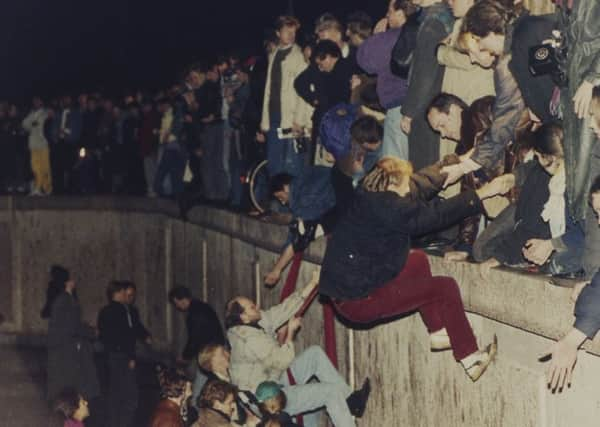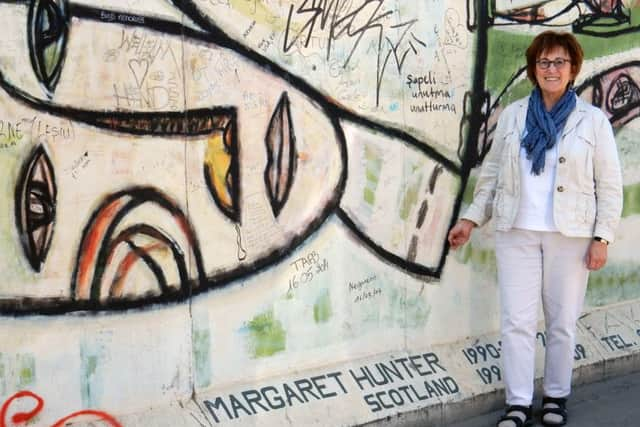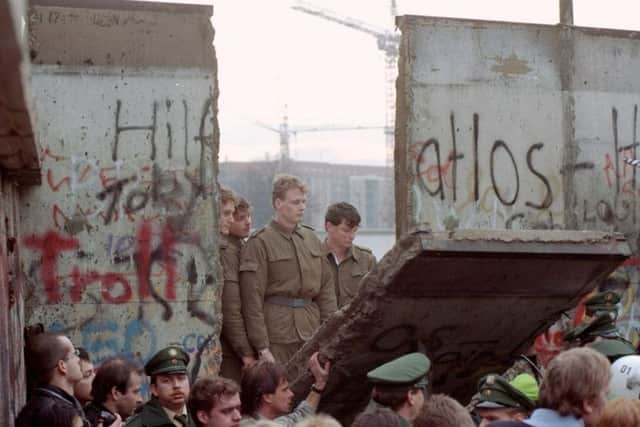Fall of the Berlin Wall: ‘It was like someone switched on colour’


Beryl Preuschmann’s memories of the fall of the Berlin Wall – which saw the border open between the East German Deutsche Demokratische Republik (DDR) and West Germany – are almost as vivid to her today as they were 30 years ago.
“I was standing on the wall, partying,” she remembers. “That’s one of those moments that you realise you’re part of history.”
Advertisement
Hide AdAdvertisement
Hide AdPreuschmann grew up in the shadow of the wall in the east of West Berlin. The two-metre-high structure cut down the middle of her street, dividing the community which had been united before 1961, when the East German government tightened the borders to stop a brain drain to the West.


“You didn’t go near it usually, you were scared of being shot,” she remembers. “If we were flying a kite, we had to be careful it didn’t get too close.”
But when the wall fell on 9 November, 1989, ending decades of Communist rule, the then 16-year-old climbed on top of the structure with her boyfriend, Sven, and watched as hordes of East Germans flocked into the West on foot and in their Trabants – the only car available in East Germany.
Unlike many of her classmates, Preuschmann had visited the East every year, to see her father’s cousin.
“Our family had been granted a visit to see us just a few months before the wall fell,” she recalls. “So we thought there was no chance they would come again so quickly, but almost as soon as it happened, we got a phone call: ‘It’s us, we’re here!’ Everyone came if they could.”


Preuschmann, who runs tourism business TRIPorganiser in Edinburgh, remembers a party atmosphere which lasted for days, sparking an uncharacteristic openness in the usually reserved German people.
“It was not typically the German way, but people would stop East Germans on the street and say ‘Come to my house for dinner’,” she says. “It was lovely.”
Different clothes, colours and even accents marked out the East German visitors in West Berlin. Banks handed out welcome packs to them, containing a small supply of Deutschmarks to be spent in the West.
Advertisement
Hide AdAdvertisement
Hide Ad“They had different haircuts and their clothes were different colours, more drab,” she remembers. “It was the 80s, so in the West, it was all neon colours and patterns. Friends of mine who grew up in East Germany told me it was like someone switched on colour when they came to the West. You could even tell who was from the East by the way they spoke, they had stronger Berlin accents.
“Soon afterwards, life went on as normal for us, but I do think that for the East, things got different very quickly.”
However, West Berlin’s special status – which gave West Berliners cheap rent and a loophole to avoid compulsory national service – changed. Although West Berlin was under West German rule, it was physically located in the East.
“We had subsidies, to encourage Germans to live there,” she says. “A phone call was a flat fee, you could talk for as long as you wanted. But after reunification, things like that disappeared.”
For Ilka Heinze, living nearly 200 miles away from Berlin in the East German city of Leipzig, life under Communism had been simple – and in some respects, easier.
“My parents never joined the [Communist] Party, so our family was probably always a little bit critical [of the system] but we just went with the flow.” she says. “It was possible to do that, but not if you wanted to do certain things in life, so they made a choice to keep their heads down. We lived a very enclosed life in our house in Leipzig and at a cottage we had, where we went at weekends and spent time sailing on a boat my dad had.
“It was a happy life for us, but we were living on borrowed time.”
In September 1989, peaceful demonstrations, demanding freedoms such as foreign travel and democratic elections began in her hometown – and soon spread across the country. In the epicentre of what became known as the “Peaceful Revolution” – in contrast to the more violent end to communist regimes in countries such as Romania – protesters took to the streets of Leipzig every Monday after a “prayer for peace” at the St Nicholas Church in the centre of the city, with demonstrations eventually spreading across the DDR. However, Heinze, by then a 20-year-old single mother with a four-year-old daughter, was not among them.
Advertisement
Hide AdAdvertisement
Hide AdShe says: “People always think of Berlin as the focus of the reunification because of the fact that the wall broke down, but the Peaceful Revolution actually began in Leipzig. I could see the protests from my office window.
“I sometimes feel bad about my decision not to raise my voice actively, but when my colleagues went out to protest, I had to go home to take care of my daughter.”
Although she relished the chance to travel freely and enjoy democracy, Heinze, who later studied a Masters degree at Edinburgh University and worked part time at Napier University, believes that she would not have enjoyed such a successful career had she not given birth to her child during the days of the DDR.
An apprentice to a payroll clerk at the time of reunification, she built on her career foundation established while her daughter was young and went on to work her way up the ranks in the newly capitalist society, eventually becoming head of human resources at a leading international accountancy firm, where she met her West German husband.
However, under communism, privileges were given to women with children to help them stay in work – such as monthly “household days” on full pay, free childcare and a reduced working week. After reunification, West German laws were brought in and socialist benefits – such as those offered to Heinze as a young mother – were axed almost overnight.
“I honestly think that if it had not been for the DDR, I would not have done what I did in my career as a young mother,” she says. “Before reunification, I had started a university course alongside my job which my work supported – I had always wanted to experience academic life – but after reunification I realised I could not do it any more so I had to leave. I also felt no stigma for being a young mother in the DDR. That felt very different in the West.
“I did not support the DDR – it was time for change – but it came at just the right time for me.”
John Wilkie, who was studying translation at Heriot Watt University at the time, spent six months of his degree course at a university in the West German town of Germersheim. He remembers watching the demise of the DDR on his hall of residence neighbour’s TV.
Advertisement
Hide AdAdvertisement
Hide Ad“I didn’t have a TV, but the student next door, who was from Poland, did,” he recalls. “I remember watching news from both West and East Germany. There was one broadcast which was basically a list of every success the DDR had supposedly had, shortly before the wall came down. It was just pure propaganda.
“My friend, who had also grown up under communism in Poland, was laughing. He said: ‘This newsreader guy doesn’t believe a word he’s saying.’”
While few foreigners lived in the DDR, those who had made a home in West Berlin, an island of capitalism in East Germany, could watch the process of reunification unfold across the border. Those wanting to travel out of West Berlin had to fly direct, or take a “transit road” – which was essentially a corridor through the East into West Germany.
Artist Margaret Hunter, from Ayr, moved to West Berlin in 1985 to study under art professor Georg Baselitz. Four years later, she found herself becoming part of a newly-united Germany.
“The actual night the wall fell, I was in Scotland for a few days because my daughter had got married,” she says. “I was painting in my studio when my husband, Joachim, came running down the stairs. He shouted to me: ‘Margaret, the wall has fallen! Look what they did when my back was turned!’ I was absolutely flabbergasted.
“The news, the TV pictures were incredible and the euphoria, it was contagious. Nobody believed that the division of Germany could suddenly change in a moment, a moment full of energy, almost like an eruption, an outburst.”
On their return to Berlin, the couple made for the Brandenburg Gate – the iconic structure where an interview with Hunter will next weekend feature as part of the city’s official 30th anniversary celebrations. In 1990, the artist was one of a group asked to paint on the previously inaccessible east side of the Berlin Wall, which eventually became known as the East Side Gallery.
She says: “We walked through and there were crowds of people everywhere. On the West side, there were queues of people from the East at the supermarkets. People were singing and I was singing and people were crying and I was crying too. The whole momentum of it and the atmosphere was amazing.”
Advertisement
Hide AdAdvertisement
Hide AdOutside of Berlin, the fall of the wall also meant the opening of the border across the rest of Germany.
Growing up in the East in a small village just 2km from the West German border, Daniela Nolte, who was 11 at the time, had witnessed the division of the local community throughout her childhood.
“My aunt lived in a village which was within a controlled zone right next to the border,” she says. “If we wanted to visit her, we had to go through a checkpoint, even though she was in the East. It was normal to us.”
When the wall fell, the West-to-East border close to Nolte’s home was opened – although East Germans wanting to travel west had to go through a border point 20km away.
“We welcomed a lot of West Germans into our area,” she remembers. “My mother worked in the food industry, so she was involved, making goulash and soups for our visitors from the West in the villages close to the border. It was so exciting, they gave us children some bits and pieces of West German money and we thought it was amazing.”
With an uncle who had escaped over the border to the West decades earlier, Nolte had visited West Germany a year before the wall fell. Usually, families were not given leave to visit the West together – for fear that they might defect.
“We were granted permission for our whole family to go over there to see relatives, which was very unusual, it was probably because the restrictions were starting to lift,” says Nolte, who now lives in Leith with her partner and two children.
“My sister and I were a little disappointed when we first went to the West – we thought it would be one giant shopping mall. As we were so close to the border, we sometimes watched western TV – although my parents told us we couldn’t tell anyone that we did that – and it had adverts of all these things we didn’t have.
Advertisement
Hide AdAdvertisement
Hide Ad“Whenever we had visitors from the West, they always brought exotic fruit we couldn’t get, like satsumas and bananas – and brightly coloured sweets – so we thought everything there was like that. When we saw they had houses and roads which just looked like where we lived, we were surprised.”
As part of the Young Pioneers movement at school, pupils were also expected to stand up and salute to a picture of Communist Party leader Erich Honecker every morning. But when the wall fell, the traditions which had been part of everyday life quickly fell away.
Nolte recalls: “They made us give everything back – the bandanas and the shirts we wore as Young Pioneers. Things gradually dropped off. There were some nice things about the East. We got together to sing songs, maybe once a week, it was nice.”
She adds: “There is something about it which has stayed with me. After I graduated, I chose to go and live in China for a while and then I came to Scotland – which I also feel is quite socialist. Now, I am with a Polish man who also grew up under communism, so something seems to have stuck which has made me the person I am today.”
Official figures from the German government published in September last year showed that the East German states’ economic power is “only very slowly” catching up to the levels enjoyed in the West. In 2017, gross domestic product per inhabitant in the East was just 73.2 per cent of that in the West.
Some former East German residents still feel that life in unified Germany is a disappointment. A poll carried out ten years ago to mark the 20th anniversary of the fall of the wall found that the majority of people from the East felt that life was better under communism.
East Berlin resident Nele Finsterbusch turned up to her job as a postwoman at 6am on Friday, 10 November, 1989 – the day after the wall fell – oblivious to the political tsunami which had hit her country.
“We delivered letters and newspapers together, but we rarely looked at them,” says Finsterbusch, who now lives in Edinburgh. “But that morning, my colleague said ‘Have you heard about this?’ and there it was on the front page. We couldn’t believe it.”y
Advertisement
Hide AdAdvertisement
Hide AdThat night, Finsterbusch had arranged to meet a friend. “She came to my house and said to me: ‘Let’s go and see, let’s go to West Berlin’,” she recalls. “I told her I was tired, that I had to get up early for work, but she insisted.” The pair crossed a minor border point and started to walk towards the city centre, eventually getting a lift from some West Berliners.
“I was disappointed,” she remembers. “I had the feeling that ‘this is not the kind of country I want to live in’. I found it quite weird, because I was brought up differently. I have a loyalty to East Germany and its people, its culture.”
Finsterbusch, who was 24 when the wall fell, never felt settled in a unified Germany, moving after a year to the Netherlands and later on to Scotland, where she now works as a teacher.
She says: “The reunification had significant mistakes, economically and the next generation are paying for these mistakes. The East was just swallowed up. People are struggling to get on their feet again.”